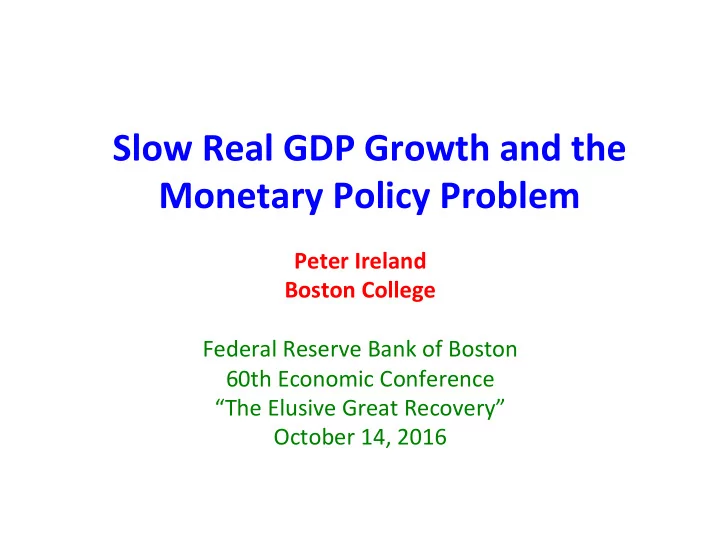

Slow ¡Real ¡GDP ¡Growth ¡and ¡the ¡ Monetary ¡Policy ¡Problem ¡ Peter ¡Ireland ¡ Boston ¡College ¡ ¡ Federal ¡Reserve ¡Bank ¡of ¡Boston ¡ 60th ¡Economic ¡Conference ¡ “The ¡Elusive ¡Great ¡Recovery” ¡ October ¡14, ¡2016 ¡
The ¡Monetary ¡Policy ¡Problem ¡ • Should ¡the ¡FOMC ¡raise ¡its ¡federal ¡funds ¡rate ¡ target ¡again ¡before ¡the ¡end ¡of ¡the ¡year? ¡ • Is ¡the ¡Fed ¡falling ¡behind ¡the ¡curve ¡or ¡sKll ¡ struggling ¡to ¡provide ¡adequate ¡sKmulus? ¡ • Look ¡at ¡the ¡behavior ¡of ¡GDP ¡for ¡clues. ¡
The ¡output ¡gap ¡is ¡almost ¡closed. ¡
But ¡potenKal ¡output ¡today ¡is ¡more ¡than ¡16% ¡lower ¡ than ¡what ¡was ¡expected ¡in ¡2006! ¡
How ¡much ¡is ¡trend ¡and ¡how ¡much ¡is ¡cycle? ¡ • CBO ¡esKmates ¡of ¡potenKal ¡GDP ¡growth, ¡2010-‑16: ¡ – 2.6% ¡(2006) ¡ – 2.3% ¡(2011) ¡ – 1.4% ¡(2016) ¡(versus ¡longer-‑run ¡trend ¡1.9 ¡– ¡2.0%) ¡ ¡ • The ¡green ¡esKmates ¡resemble ¡SW’s ¡and ¡reflect ¡ demographic ¡and ¡long-‑term ¡producKvity ¡trends. ¡ • The ¡red ¡number ¡reflects ¡slow ¡intermediate-‑term ¡ producKvity ¡growth, ¡which ¡also ¡shows ¡up ¡in ¡the ¡ SW ¡esKmates, ¡but ¡in ¡the ¡cyclical ¡components. ¡
The ¡shrinking ¡CBO ¡output ¡gap ¡reflects ¡slower ¡growth ¡in ¡ potenKal, ¡not ¡faster ¡growth ¡in ¡real ¡GDP! ¡
How ¡much ¡is ¡trend ¡and ¡how ¡much ¡is ¡cycle? ¡ • What ¡is ¡going ¡on ¡with ¡producKvity? ¡Is ¡this ¡ enKrely ¡due ¡to ¡supply-‑side ¡factors? ¡ • We ¡know ¡from ¡Orphanides ¡that ¡output ¡gap ¡ mismeasurement ¡can ¡be ¡a ¡huge ¡problem ¡for ¡ monetary ¡policymaking. ¡ • Is ¡there ¡any ¡chance ¡we ¡could ¡be ¡overesKmaKng ¡ the ¡impact ¡of ¡trends ¡in ¡the ¡current ¡environment? ¡ ¡
The ¡Monetary ¡Policy ¡Problem ¡ • Already, ¡the ¡Stock-‑Watson ¡esKmates ¡point ¡to ¡ fiscal ¡policy ¡as ¡being ¡surprisingly ¡Kght ¡and ¡foreign ¡ demand ¡as ¡unusually ¡weak. ¡ • Could ¡insufficiently ¡accommodaKve ¡monetary ¡ policy ¡be ¡partly ¡to ¡blame, ¡too? ¡
Monetary ¡aggregates ¡have ¡been ¡ignored ¡since ¡the ¡ mid-‑1990s, ¡but ¡are ¡sKll ¡leading ¡indicators. ¡
Money ¡and ¡output ¡are ¡sKll ¡correlated ¡over ¡the ¡cycle, ¡ but ¡the ¡lags ¡have ¡gocen ¡longer. ¡ BUSINESS ¡CYCLE ¡CORRELATIONS: ¡ REAL ¡GDP ¡AND ¡LAGGED ¡DIVISIA ¡MONEY ¡ Sample ¡Period ¡ M1(t−k) ¡with ¡Y(t) ¡ M2(t−k) ¡with ¡Y(t) ¡ 1967:1 ¡– ¡2016:2 ¡ 0.32 ¡ k ¡= ¡4 ¡ 0.45 ¡ k ¡= ¡4 ¡ 1967:1 ¡– ¡1983:4 ¡ 0.80 ¡ k ¡= ¡2 ¡ 0.84 ¡ k ¡= ¡2 ¡ 1984:1 ¡– ¡1999:4 ¡ 0.45 ¡ k ¡= ¡7 ¡ 0.41 ¡ k ¡= ¡8 ¡ 2000:1 ¡– ¡2016:2 ¡ 0.73 ¡ k ¡= ¡8 ¡ 0.69 ¡ k ¡= ¡11 ¡ See ¡Michael ¡Belongia ¡and ¡Peter ¡Ireland. ¡“Money ¡and ¡Output: ¡Friedman ¡and ¡Schwartz ¡ Revisited.” ¡ Journal ¡of ¡Money, ¡Credit, ¡and ¡Banking , ¡September ¡2016. ¡
The ¡Fed ¡appears ¡to ¡have ¡pulled ¡back ¡too ¡soon ¡in ¡2010. ¡
From ¡a ¡quanKty-‑theoreKc ¡perspecKve, ¡policy ¡has ¡ Kghtened ¡and ¡now ¡seems ¡about ¡right. ¡
The ¡Monetary ¡Policy ¡Problem ¡ • A ¡lot ¡of ¡uncertainty ¡about ¡long ¡and, ¡especially, ¡ intermediate-‑term ¡producKvity ¡trends. ¡ • Tight ¡fiscal ¡policy, ¡weak ¡foreign ¡demand, ¡and ¡ (inadvertently) ¡Kght ¡monetary ¡policy ¡probably ¡ have ¡something ¡to ¡do ¡with ¡the ¡slow ¡recovery. ¡ • Against ¡this ¡backdrop, ¡a ¡cauKous ¡and ¡gradual ¡ approach ¡to ¡raising ¡rates ¡seems ¡fully ¡appropriate. ¡
Recommend
More recommend